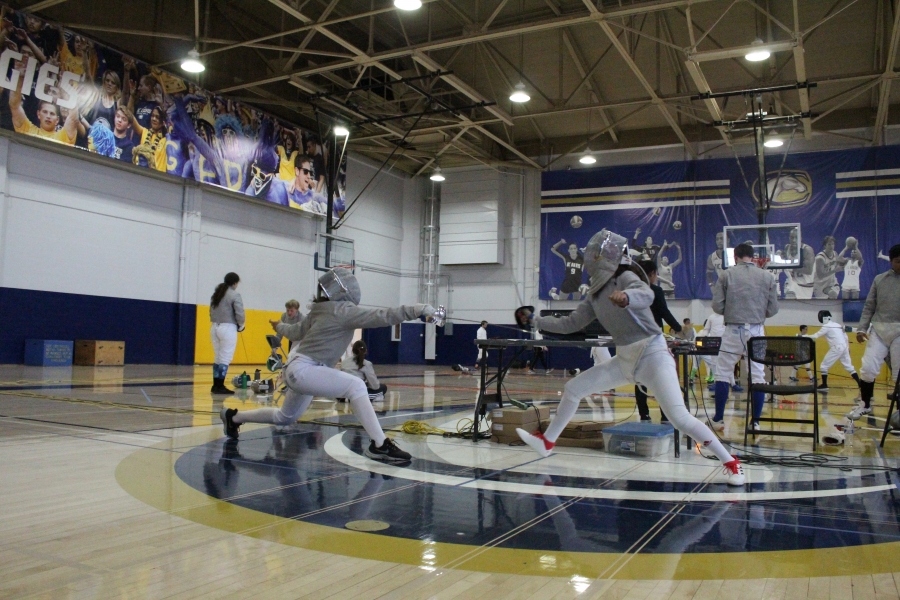
Club fencers land in top three of individual events
The sound of fencing weapons clashing and shoes pounding the hardwood floors echoed through Hickey Gym as fencers from UC Davis and seven other colleges (including UC Berkeley, UC Santa Cruz, Cal Poly San Luis Obispo and University of Nevada Reno) competed in a two-day tournament hosted by the UC Davis Fencing club from May 5-6.
All in all, nearly 100 fencers competed across three individual and team versions of these events: épée, foil and sabre. Five UC Davis fencers fought their way into the top three of the individual events and one novice placed second in novice foil.
First-year Ph.D. candidate in integrative pathobiology and co-president of UC Davis Fencing Arturo Oliver Guimera won gold in mixed épée and spoke on his path to first place.
“My mind was into it, I fought really tough people, but I bested them,” Guimera said. “Winning here in Davis, that’s awesome.”
In fact, Guimera was so intensely focused in the gold épée round that he didn’t realize he’d won the round.
“I couldn’t believe it at the beginning — I was not keeping track of the points,” Guimera said.
He was waiting for the judge to say, “en-garde, ready, fence”, but the gold round was over, 10-7.
“So when I [went] for the last point, I just went back to my position and tried to fence again, they said ‘no, no, you’re done’, I was really excited,” Guimera said.
The events are named after the weapons used, and have rules that are specific to the event. The épée weighs approximately 27 ounces and is the heaviest of all swords. Fencers can only score a point with the tip of the sword, but anywhere on the body is fair game in épée. Because of this, fencers need to be more cautious of their moves.
Foil is similar to épée in that fencers must score with the tip, but the scoring area is smaller — only the torso, groin and back. Contact with anywhere else halts play until fencers get back into position.
In foil, fencers must establish the “right-of-way” for their point to count, which is determined by a judge. It boils down to two essential elements which judges evaluate, initiating an attack and forward movement. In the event that both fencers simultaneously land a hit, the judge must determine who had priority. Attacks can also be parried and followed up with a counterattack, a method of establishing priority defensively.
Foil and fencing rounds last until a fencer gets 10 points, so these rounds can get highly strategic and heated. Fencers occasionally celebrate with a triumphant roar, explained by UC Davis fencers as a strategy to exude confidence in the bout — judges may view this confidence as a sign that fencer landed the hit first.
Sabre is the quickest and most aggressive of the three types.
The points are lightning-fast, with fencers making split-second decisions.
The whole upper body is the target, priority must be established and any part of the weapon can be used to score a point. The first fencer to 15 wins the bout. Sabre is often described by fencers as a “Pirates of the Caribbean” style of fighting because of the speed of the movements and the way the sword is held.
Fencers’ gear is hooked up to equipment that registers a touch and shows up on the judges box, who then interprets the play and decides which fencer won the point, or can decide to reset the point.
Fencing bouts are a combination of finesse, solid footwork and mental toughness.
When third-year animal science major Tyra Tse found herself down 7-3 in a direct elimination foil bout, she had to concentrate her efforts on one thing.
“I was just trying to keep as calm as possible,” Tse said. “I knew that he wanted me to get mad, or he just wanted a reaction out of me.”
Tse focused and leaned toward defense until she started to rally back, and her teammates were exuberant when she tied the bout 8-8. For her, the formula for winning the bout was simple.
“I was like ‘be calm, collected and beat his butt,’ that’s it,” Tse said.
Tse got revenge against her opponent and was very happy she was able to stage a comeback, exhibiting mental toughness.
“It was really good, after hearing him scream a lot,” Tse said. “I got the last point and I was able to scream back.”
Fourth-year neurobiology physiology and behavior major Oliver Duan is a sabre fencer who is usually calm and confident going into his bouts. Duan described his mindset after beating his opponent 15-6, advancing to the round of 8.
“I was pretty relaxed going into it,” Duan said.
Although Duan appeared to comfortably secure the bout, he had to quickly adjust his play because of the defensive style his opponent played, which opened Duan up to counterattacks.
“I went on to figure out I needed to shorten my attacks, to not project as much,” Duan said.
Duan went on to place third in sabre, losing to third-year plant science major Benjamin Louie. Louie placed second in sabre.
Fencing is often referred to as physical chess, and fencing weapons are said to be the second fastest moving object in Olympic sports (behind bullets in the marksman event).
The sport demands that fencers make quick calculations and learn about the opponent. Guimera, who started fencing with his dad in Castellon de la Plana, Spain, says this is what he enjoys about fencing.
“It’s really cool when you have these games because you start to learn about each other,” Guimera said. “It’s really entertaining when you get into it.”
Written by: Bobby John — sports@theaggie.org




